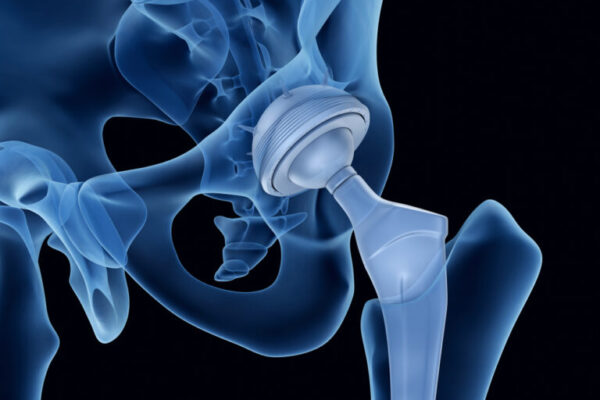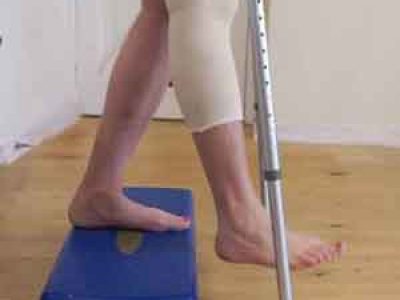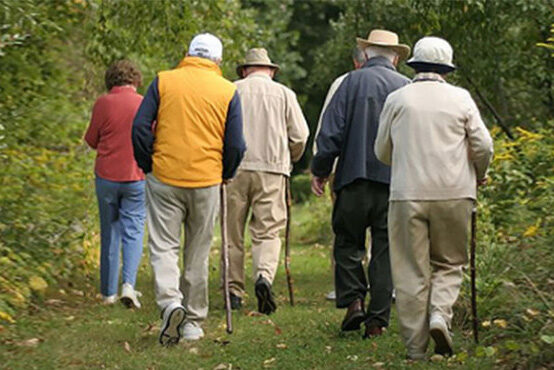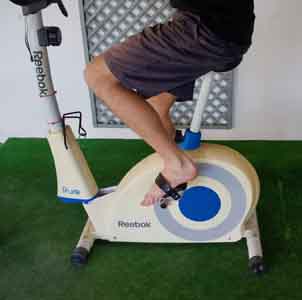Anatomy of the Hip
The hip joint is a type of joint known as a ball and socket joint. The cup side of the joint is known as the acetabulum and is situated in the pelvis and the ball is located on the end of the long thigh bone( the femur). This joint is particularly prone to arthritis as it is one of the main weight bearing joints of the body. Both the surfaces of the cup and the head have a thin layer of articular cartilage covering them. In arthritis this erodes away and the bone surfaces begin to rub against each other causing pain and stiffness.
If you have a BMI over 30 you are 4 times more likely to have arthritis and if your BMI is over 40 you are 20 times more likely to wear out the joint and need surgery.
In a total hip replacement( THR) the acetabulum is replaced either with a plastic or ceramic component and the head of the femur is replaced with a metal stem with either a metal or ceramic head which is inserted into the shaft of the femur.
Due to the method the surgery is performed and the muscle weakness that follows the surgery there is a slight risk of the hip dislocating until the soft tissue around the new hip has healed.
All the advice below is designed to help reduce this risk and to help you to get the maximum benefit from your new hip.
To reduce the risk of dislocation it is best you do not bend your hip beyond a right angle and do not cross your legs for 6 weeks.
General advice
Pain
The amount of pain after the surgery varies hugely from person to person.The operation will give you instant relief from the arthritic pain from the joint itself but you will feel some pain from the soft tissues surrounding the joint.
It is always best to manage pain by taking your medication regularly so do not try to be brave.
After you are discharged you may feel some pain for a few weeks. Listen to your body and use the level of pain as a guide when increasing your daily activities.
A moderate ache which settles quickly is acceptable, severe pain which takes hours to settle is not.
If you experience a sharp pain, stop activity immediately.
If symptoms persist, contact your GP for advice.
Swelling
Some swelling in the leg is to be expected and it may persist for three months or more.
If the leg is very swollen resting on the bed for an hour or so in the afternoons will help and may be a good idea anyway to prevent swelling.
It is very important to move your feet up and down regularly whether you are in bed or in the chair. Moving your feet up and down uses your calf muscles which helps pump blood and swelling up the leg.It also helps prevent any clots from forming.
If you wish you may also ice your thigh to help the swelling. You may use crushed ice, a gel pack or a pack of frozen peas, which must be wrapped in a damp towel or tea towel before being placed on your thigh.
Leave on for a maximum of 10 mins and then no less than 20 mins before you repeat it.

Infection
If the area around the wound becomes red, increasingly more painful or there is abnormal discharges and/or you become unwell with a high temperature contact your GP immediately.
You must also contact your surgeon to organise an early review.
Mobilising
If you have your operation in the morning the physiotherapist will come and get you up and out of bed that afternoon, otherwise you will get up the next morning.
Most patients are allowed to fully weight bear with the aid of crutches/ or frame if needed. This will be confirmed by your physiotherapist when they see you after your surgery.
You will start with two crutches both indoors and out until you are confident to move around the house with only one (held in the opposite hand to the bad leg) or none. If you have any form of limp it is better to continue with the crutches.
See video how to walk with crutches if you are unsure.
Outside it is best to use two crutches until you can walk safely with no limp.When you feel able progress to just one and then none dependant on the type of operation and your surgeons protocol.
Points to aim for when walking
1. Make sure that both steps are equal in length.
2. Timing- Try to spend the same amount of time on each leg.
3. Heel Toe movement-Always put the heel of each foot to the ground first.
4. Gradually increase your walking distance and amount of activity that you do each day.
Sitting
The height of the chair is very important and will have been discussed before your operation. You may have been given chair raisers to make sure it is not too low and an extra height surround on your toilet.
When sitting your knee should be lower than your hip. Remember not to bend your hip more than 90 degrees at this stage.
See Products Chair raisers
To sit down, stand close enough to feel the chair against the back of your legs. Put both crutches in to one hand and reach back to the arms of the chair with the free hand and placing the operated leg forward a little gently lowering yourself into the chair.
With a frame it is the same procedure make sure you put at least one hand and preferably both to lower yourself down.
To stand up place the operated leg out in front of you and push up with both hands on the arms of the chair. Once you are balanced place your hands on the frame.
If you have crutches then place in one hand as before and push up with one hand on the arm of the chair. Once you feel balanced place the crutches or sticks in to both hands.
Never use the frame to pull yourself up.
Stairs
Before you come home the hospital physiotherapist will have gone through this with you.
To begin with it is better to go up or down the stairs one step at a time. Place the crutches or sticks in one hand and hold onto the rail/ bannister with the other.
Going up you should place the un-operated leg on the step above first, followed by your operated leg and crutch or stick.
Coming down stairs you should place your operated leg together with your crutches or sticks in one hand onto the step below first, followed by your un-operated leg last. Make sure you are holding the bannister with one hand at all times.
Remember the rhyme Good leg up to Heaven and Bad leg down to Hell!
If you are muddled watch the video how to do stairs with crutches.


Getting in and out of bed
It is not necessary to get out of bed the same side as your operated hip and get in the other side as long as you are careful to prevent yourself crossing your leg beyond the midline.
Initially it can be helpful if someone supports your leg as you get in and out of bed.
Getting in and out of the car
Positioning the car: you should sit in the front passenger seat of the car after your operation as there is more leg room. Make sure the car is parked away from the kerb so you can be on the same level as the car before you get in.
The seat should be pushed back as far as possible and slightly reclined.
Go bottom first into the car and lower yourself slowly to the edge of the seat.
Use your arms and lift your bottom further across the seat towards the driver’s side.
Lift your legs into the car slowly.
A plastic bag on the seat will help you swivel your legs in more easily but this must be removed before you drive off to avoid sliding off the seat in an emergency stop.
Reverse this procedure to get out.
Functional activities
When dressing there are several aids, which may be of benefit but these are not essential i.e. a helping hand, sock aid or long handled shoe horn.
The occupational therapist (OT) will give you information on where these aids can be obtained.
Some may be provided by the hospital but you may be expected to buy them.
You will probably be advised to have a raised toilet seat, again often provided by the hospital at a cost, and you may well be asked to bring it with you on admission. If it is not provided or discussed with you and if your toilet is particularly low you might like to purchase a raised toilet seat to use for the first week or so.
Follow the advice from your occupational therapist on how to manage in the kitchen and bathroom.
Washing
Showering is the best option for the first 6-8 weeks after your operation as you may struggle to get in and out of the bath. It is also a better way to avoid any infection.
If you do not have a walk-in shower or access to one, you will have to have a standup strip wash until you can get in the bath.
You may initially require help to wash and dry your feet or may manage with a combination of a helping hand and/or a long-handled brush/sponge.
Dressing
Before you come into hospital arrange your clothes so that you can reach them easily for the first week after you return from hospital or at least until the hip becomes less uncomfortable and more flexible.
The OT may recommend some dressing aids.
How to get dressed:
Collect your clothes and your three dressing aids (if using them) and sit somewhere comfortable not too low with a firm base before you start.
If you have purchased the dressing aids:
1. The helping hand can be useful initially for putting on underwear, trousers and skirts until you can bend far enough to do it yourself.
2. It is easier to put your operated leg in first when dressing and last when undressing.
3. The sock aid can be useful for putting on socks until you are flexible enough to do it yourself.
4. The long handled shoe horn can be useful initially to put your shoes on, and to push your socks, stockings or tights off until you are flexible enough to do it yourself.


In the Kitchen
Rearrange the contents of your fridge and cupboards so you can reach the more essential items without bending down.Buy in all the essentials you need and stock up the deepfreeze with precooked meals that can be easily cooked.
A high stool is useful to sit on when you are preparing vegetables or for eating meals if you are unable to carry it to the dining table.
All heavy work i.e. hoovering, making beds and cleaning should be done by somebody else.
Driving
In order to drive you need to be nearly pain free, not be dependent on walking aids, have a good range of movement and have sufficient reflexes to manage an emergency stop this is usually six weeks after your operation but may be less.
Have a “test drive” and practice an emergency stop before driving on your own.
It is always advisable to contact your insurance company before you resume driving to tell them that you have been cleared as fit to drive following your THR. Failure to do so may affect your policy.
Work
Check with the surgeon when you can go back to work this will depend on the nature of your work. For a desk job it will be 4-8 weeks off work and for a more physical job it will be anything up to 3 months.
If you need a medical certificate for your employer ask for it before you leave hospital or get it from your GP.


Sports and hobbies
Recommended activities include walking, swimming, static bike, golf and dancing. Sports which involve high impact, such as running and jumping should be avoided i.e. jogging, singles tennis, basketball, football.
Activities such as roller skating, ice skating, horse riding, cycling on the road, downhill skiing maybe recommenced if you have participated in these activities before but they are considered high risk and should not be taken up as a new activity after a total hip replacement.
Gardening is fine. Long handled tools may be useful when weeding and the heavy work should be left for 3 months.
Sex
You should be the passive partner while you are recovering.
If you would like further advice please ask the OT.
Travelling
It is not advisable to fly within 6 weeks of having a joint replacement due to the increased risk of deep vein thrombosis (blood clot).
Check up after discharge
Your clinic appointment should be made by ward staff before you are discharged and will be 6-8 weeks after your operation.
Physiotherapy follow-up is also arranged dependent on circumstances and where you live.
Extracts taken from Berkshire Hospital orthopaedic physio dept and Hampshire NHS/BMI information sheet
see link below for Exercise sheet for Hip exercises after Hip replacement

